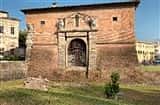Stay
Visit a locality browsing the menu on the left. In each Italy area you can then choose the best touristical structures we are proposing.
Most viewed in
Italy
-
The Chiorri Winemakers Company is a vineyard under family management, which with special care from their very own vines, produces D.O.C. Colli Perugini and IGT dell'Umbria white, red and rosè wines. The family, together with the help of experienced workers,...
-
Farmhouse San Rocco, country holiday home in Umbria, Todi Summer holidays in Umbria, in Todi at Tenuta San Rocco Tenuta San Rocco has the pleasure to offer special conditions for accomodations in his flats or " casolari" You may test the tipical foods...
-
The first traces of Bisol family in the heart of the Prosecco D.O.C area date to the 16th century and are contained in a census carried out for fiscal reasons by the aristocratic Venetian family Da Pola, who were landowners of the leading the very prestigious...
-
In 1964, Alibrando Dei, Maria Caterina's grandfather, bought the first part of the entire estate : Bossona. This vineyard is gorgeous for exposition and kind of soil, a sort of amphitheater always where the wind blows with a certain constancy. And her...
-
Poggio al Casone is a charming resort located in a private wine farm surrounded by 40 hectares of organic vineyards. An ancient villa and two independent cottages have been meticulously renovated offering now self-catering apartments available for holidays....
Print this page
Send to a friend by e-mail
The furnace of Porta San Donato
-

The structure of the furnace of Porta San Donato was, in the local area, an unique example in its genre. Characterized by a rather particular conformation, linked to a production of "fine ceramics" , although it has also been used for the production of common ceramics frequently used in the preparation of Lucca dining tables. Why was used a furnace with this conformation for the production of precious artefacts with so little demand at local level? The answer to this question is in the historical documents about the furnace and its use.
We learn from these documents that in 1643, after the creation of a new entrance to the city, the huge spaces of the old gate of San Donato, were assigned to the Genoese craftsman Giovanni Antonio Salomoni, for the creation of a pottery factory. The furnace "indirect cooking" was necessary in the production of high-level majolica. Unfortunately we do not have findings of this production. Instead we have a large amount of artefacts related to the production of the so-called «graphite» ceramic, a much more common type.
It is natural to think that the Genoese craftsman Salomoni had come to Lucca to export in our area his precious majolica, for the creation of which a proper structure was needed. Unfortunately, this product was unsuccessful in Lucca, and Salomoni was forced to choose for the production of less valuable ceramics, but very much in demand locally. The production was then changed, but the structure of the furnace remained the same, this allowed him to use a refined workmanship in the production of a more common material.